| << Chapter < Page | Chapter >> Page > |
While interpretation of an ECG is possible and extremely valuable after some training, a full understanding of the complexities and intricacies generally requires several years of experience. In general, the size of the electrical variations, the duration of the events, and detailed analysis provide the most comprehensive picture of cardiac function. For example, an amplified P wave may indicate enlargement of the atria and an enlarged Q wave may indicate a MI (Myocardial Infarction). T waves often appear flatter when insufficient oxygen is being delivered to the myocardium.
As useful as analyzing these electrical recordings may be, there are limitations. For example, not all areas suffering a MI may be obvious on the ECG. Additionally, it will not reveal the effectiveness of the pumping, which requires further testing, such as an ultrasound test called an echocardiogram or nuclear medicine imaging. Common abnormalities that may be detected by the ECGs are shown in [link] .


When arrhythmias become a chronic problem, the heart maintains a junctional rhythm, which originates in the AV node. In order to speed up the heart rate and restore full sinus rhythm, a cardiologist can implant an artificial pacemaker , which delivers electrical impulses to the heart muscle to ensure that the heart continues to contract and pump blood effectively. These artificial pacemakers are programmable by the cardiologists and can either provide stimulation temporarily upon demand or on a continuous basis. Some devices also contain built-in defibrillators.
The heart is regulated by both neural and endocrine (i.e. hormonal) control, yet it is capable of initiating its own action potential followed by muscular contraction. The conductive cells within the heart establish the heart rate and transmit it through the myocardium. The contractile cells contract and propel the blood. The normal path of transmission for the conductive cells is the sinoatrial (SA) node, atrioventricular (AV) node, atrioventricular (AV) bundle, bundle branches, and Purkinje fibers. Recognizable points on the ECG include the P wave that corresponds to atrial depolarization (i.e. contraction), the QRS complex that corresponds to ventricular depolarization, and the T wave that corresponds to ventricular repolarization (relaxation).

Notification Switch
Would you like to follow the 'Human biology' conversation and receive update notifications?